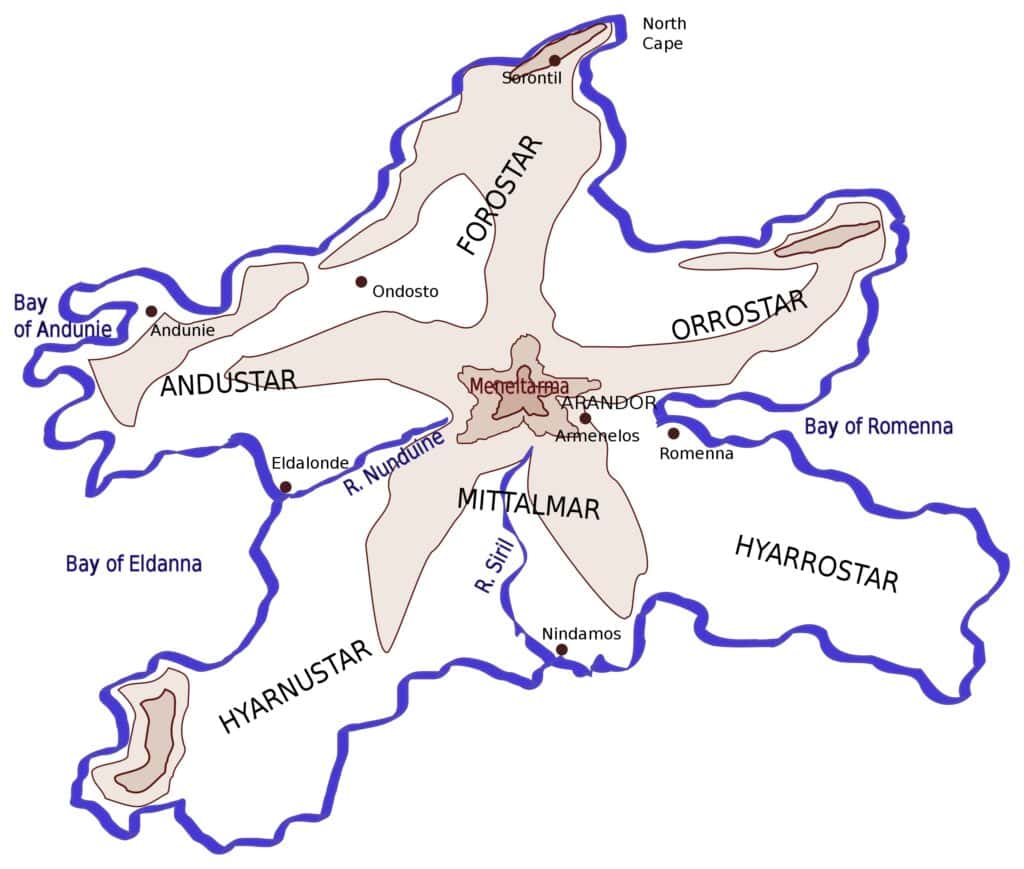Table of Contents

Tolkien himself famously ascribed his Atlantis Complex to a haunting dream:
I say this about the ‘heart’, for I have what some might call an Atlantis complex. Possibly inherited, though my parents died too young for me to know such things about them, and too young to transfer such things by words. Inherited from me (I suppose) by one only of my children [Michael], though I did not know that about my son until recently, and he did not know it about me. I mean the terrible recurrent dream (beginning with memory) of the Great Wave, towering up, and coming in ineluctably over the trees and green fields. (I bequeathed it to Faramir.) I don’t think I have had it since I wrote the ‘Downfall of Númenor’ as the last of the legends of the First and Second Age.
Letter 163: 7 June, 1955
This legend or myth or dim memory of some ancient history has always troubled me. In sleep I had the dreadful dream of the ineluctable Wave, either coming out of the quiet sea, or coming in towering over the green inlands. It still occurs occasionally, though now exorcized by writing about it. It always ends by surrender, and I awake gasping out of deep water. I used to draw it or write bad poems about it.
Letter 257
Downfall of Númenor
“Downfall of Númenor,” also known as “Akallabêth,” is a story written by J.R.R. Tolkien, featured in “The Silmarillion.” It details the history and eventual downfall of Númenor, a great island kingdom of Men in Tolkien’s Middle-earth legendarium. Here’s a summary:
Setting
Númenor: An island gifted to Men by the Valar, the god-like beings of Tolkien’s universe, as a reward for their help against the first Dark Lord, Morgoth.
Key Points
Rise of Númenor: Númenor, populated by the Dúnedain, becomes a powerful and advanced civilization. Initially, they are faithful to the Valar and friends of the Elves.
Sauron’s Influence: Over time, pride and the fear of death grow among the Númenóreans. Sauron, Morgoth’s former lieutenant and the new Dark Lord, surrenders to Númenor and subtly corrupts them, turning them against the Valar and the Elves.
Cult of Darkness: Under Sauron’s influence, the Númenóreans begin to worship Morgoth, engaging in human sacrifices and renouncing the Valar. Their King, Ar-Pharazôn, grows increasingly tyrannical.
Forbidden Voyage: Sauron convinces Ar-Pharazôn to wage war against the Valar by sailing to the Undying Lands (Aman) to gain immortality. This act is forbidden, as Mortal Men are not allowed in Aman.
Downfall and Cataclysm: As the Númenórean fleet lands on Aman, the Valar call upon Eru Ilúvatar, the supreme deity. Eru intervenes directly, changing the shape of the world. Númenor is destroyed, sunk beneath the sea, and the world is made round. The Undying Lands are removed from the physical world, accessible only to Elves.
Aftermath: The few faithful Númenóreans who had opposed Sauron’s influence, led by Elendil and his sons, Isildur and Anárion, escape the destruction. They sail east and establish the kingdoms of Arnor and Gondor in Middle-earth, setting the stage for the events in “The Lord of the Rings.“
Themes
Hubris and Downfall: A central theme is the danger of pride and the desire for power and immortality, leading to ruin.
Corruption and Influence: Sauron’s ability to corrupt and turn the Númenóreans against their benefactors reflects the insidious nature of evil.
Mortality and Fate: The story explores the human struggle with mortality and the desire to escape it.
Legacy
This tale adds depth to the history of Middle-earth and sets the background for many elements in “The Lord of the Rings,” especially the lineage of Aragorn and the history of Gondor and Arnor.
The Numenoreans
“The Numenoreans of Gondor were proud, peculiar, and archaic, and I think
Letter 211: 14 October 1958
are best pictured in (say) Egyptian terms. In many ways they resembled
‘Egyptians’ – the love of, and power to construct, the gigantic and massive.
And in their great interest in ancestry and in tombs.”
Meneltarma
Meneltarma was a mountain of Númenor. Its name means, in Quenya, Pillar of the Heavens. It was the highest place in Númenor, and it is said that those with better eyesight could see Tol Eressëa from its summit. After the Fall of Númenor, when the island was submerged, the remnants of the Dúnedain believed that the top of Meneltarma still rose above sea level. The mountain is said to rise gently from the ground initially, with five long, low ledges covered in grass. They were the Tarmasundar , the Roots of the Pillar, which extend towards the five peninsulas that form the Island. Then, towards the top, the slopes begin to become much more vertical, making the climb more difficult. The top of Meneltarma was flat and wide, capable of holding many people. It was considered the most sacred site in Númenor, a temple to Eru Ilúvatar , and nothing was built there. Only the Kings of Númenor were allowed to speak about its top, and only during the festivals dedicated to Eru, which will be mentioned below. The other people could climb up, but the sensation was so terrifying that they themselves felt unable to speak. Only Eagles lived there, and the Númenóreans believed it was Manwë who sent them to keep watch. It is said that Queen Tar-Míriel, foreseeing the destruction of the island, tried to climb to the top of Meneltarma to escape the disaster, but the great wave caught her before she could achieve the feat.
Andalusia
The name “Andalusia” is derived from the Arabic word Al-Andalus (الأندلس), which in turn may be derived from the Vandals, the Goths or pre-Roman Iberian tribes. The toponym al-Andalus is first attested by inscriptions on coins minted in 716 by the new Muslim government of Iberia.

Downfall of Atlantis
The Downfall of Númenor is a morality tale, but at its heart is not the corruption of riches, nor even of Sauron’s black magics. Tolkien’s Númenor is brought down by its people’s inescapable fear of Death. Similar to Mathias de Stefano’s memory: The people of Atlantis knew their time was about to end, but they wanted to extend there time on earth.
Gondor
Númenor has colonies, who inherit some memory of the Old Kingdom. Specifically, Tolkien’s go-to analogy for Gondor was Egypt… and Egypt is a colony of Donnelly’s Atlantis, just as Gondor is a colony of Tolkien’s Númenor.
note: Gon d’or -> Gon of gold
Noah
Tolkien in a 1951 letter refers to Elendil as a Noachian figure. Donnelly argues that the Biblical Flood represents a folk memory of Atlantis, so Donnelly would be taking the comparison the other way, turning Noah into an Elendil.
Elendil was the father of Isildur and Anárion, a survivor of the Downfall of Númenor, and the founder and first High King of the Realms in Exile.
Elendil was also known as Elendil the Tall, as he was the tallest of the Men who escaped the Downfall. Accounts differ as to his exact height, but he was at least seven feet tall.
